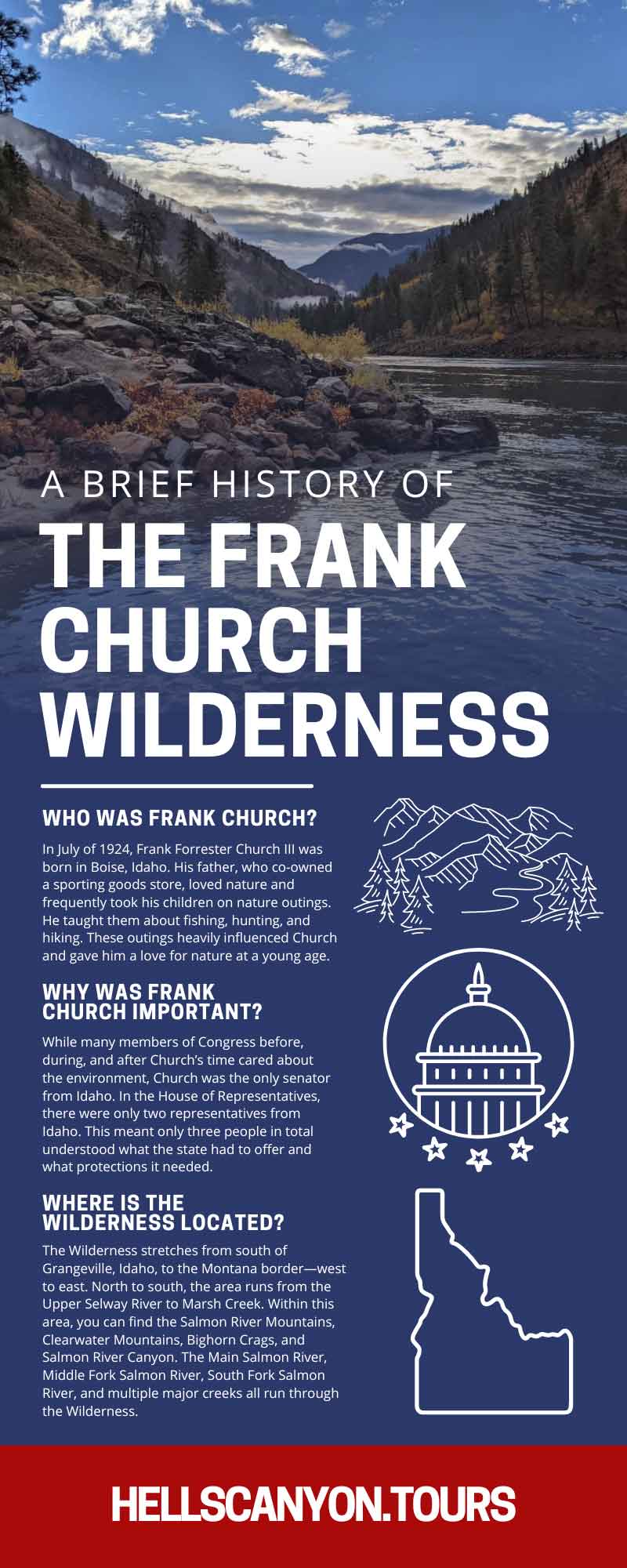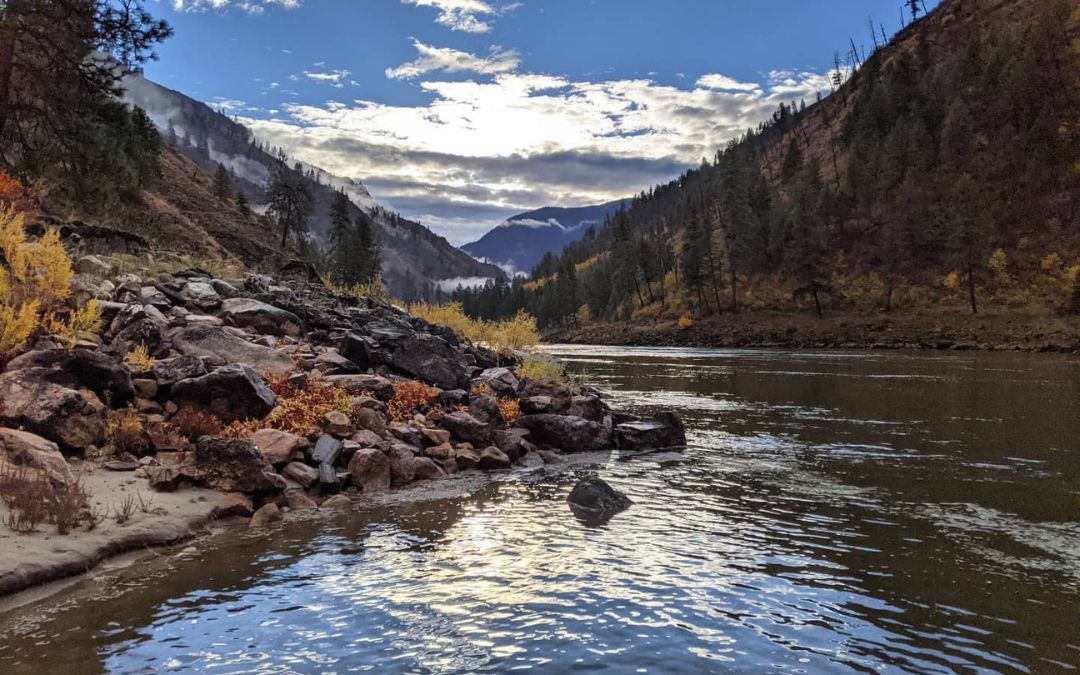The U.S. is full of fascinating history, especially when it comes to our natural wonders. These wonders have existed for hundreds and even thousands of years, but people from the U.S. didn’t always know about or appreciate them. One man who was instrumental in helping people understand the importance of protecting nature was Frank Church. Keep reading to learn a brief history of the Frank Church Wilderness.
Who Was Frank Church?
In July of 1924, Frank Forrester Church III was born in Boise, Idaho. His father, who co-owned a sporting goods store, loved nature and frequently took his children on nature outings. He taught them about fishing, hunting, and hiking. These outings heavily influenced Church and gave him a love for nature at a young age.
He also developed a love for politics, greatly admiring Idaho senator William Borah, and hoped to become a senator someday. First, though, he would attend college, serve in the U.S. Army, beat cancer, get married, and graduate from law school. After several failed attempts to run for office, the people of Idaho elected him to the Senate in 1956. He would serve in the Senate until his defeat in 1980.
During his time in Congress, Church championed many causes, including environmental protections. He was the floor sponsor of the Wilderness Act in 1964 and sponsored the Wild and Scenic Rivers Act in 1968. While these acts helped protect wilderness areas and rivers across the U.S., he also worked closer to home. He worked with other Congress members from northwestern states to establish the Hell’s Canyon National Recreation Area, the Sawtooth Wilderness and National Recreation Area, and Idaho’s River of No Return Wilderness.
In 1984, President Ronald Reagan renamed the River of No Return Wilderness the Frank Church River of No Return Wilderness in honor of his environmental efforts. Church died from cancer within the following month.
Why Was Frank Church Important?
While many members of Congress before, during, and after Church’s time cared about the environment, Church was the only senator from Idaho. In the House of Representatives, there were only two representatives from Idaho. This meant only three people in total understood what the state had to offer and what protections it needed.
Congress might not have implemented those protections if Church and his colleagues had not passionately advocated for them. Idaho has some of the most beautiful, protected lands we enjoy today, thanks to their hard work over forty years ago.
Where Is the Wilderness Located?
The Wilderness stretches from south of Grangeville, Idaho, to the Montana border—west to east. North to south, the area runs from the Upper Selway River to Marsh Creek. Within this area, you can find the Salmon River Mountains, Clearwater Mountains, Bighorn Crags, and Salmon River Canyon. The Main Salmon River, Middle Fork Salmon River, South Fork Salmon River, and multiple major creeks all run through the Wilderness.
The River of No Return gets its name from the Main Salmon River. Boats could travel down it but could not return due to its strong rapids.
What Is the History of This Wilderness?
Before the Wilderness became what it is today, it was the home of many native tribes. The two most recent tribes to live in this area were the Nez Perce and Shoshone. People continue to discover artifacts from these native tribes and other peoples who inhabited the area, such as missionaries and hunters. Some of the Shoshone tribe survived in the most isolated part of the Wilderness until the late 1900s, but most were forced out.
The Sheepeater War in 1879 was the start of forced removal. Sheepeater was a popular nickname for the Shoshone tribe. White settlers waged this war against the Shoshone after miners were killed in the area, although there was no evidence of Shoshone or native tribe involvement. Most likely, the White men in the area wanted more space for themselves since gold was discovered nearby in the mid-1860s. They forced most of the tribes onto a reservation following the tribe’s surrender. Although the White men were losing the war, the tribes were confused and often bored with their haphazard strategies. They surrendered to bring the war to an effective end. The gold rush continued after their surrender and brought many settlers to the area who built camps, ranches, and towns.
Following the gold rush, many settlers found new value in the river. Instead of looking for gold, they began attempting to run the rivers. The strong currents and rapids made this an exciting but dangerous feat. They attempted these life-threatening runs in rafts, canoes, and boats. Many of the first runs were unsuccessful, but the sport grew in popularity, and eventually, people completed the runs. Some runners would return to the area to repeatedly run the river and even invite spouses and newspaper writers to join them.
What Is the Frank Church Wilderness Like Today?
River running is still a popular sport in the Frank Church River of No Return Wilderness. With technologically advanced equipment, jet boats, and better maps, running the river is an enjoyable hobby instead of a life-or-death situation.
Many also visit the Wilderness area for other reasons—such as excellent fishing, especially fly-fishing, and hiking opportunities. The Wilderness allows for hunting, rock climbing, and swimming in certain areas. People also come to the area to practice wildlife and landscape photography, camp, and go on historical tours. There’s truly something for everyone in the beautiful Wilderness, which is why we’re so grateful that Frank Church fought to protect it.
Now that you understand some of the brief history behind the Frank Church Wilderness, you can better appreciate the area on your next visit. Idaho is full of beautiful sites, from Hell’s Canyon to the Frank Church Wilderness.
We offer some of the best Hell’s Canyon jet boat tours to enjoy during your trip. We also offer jet boat tours of the Salmon River if you want to ride a jet boat through part of the Frank Church Wilderness.
Jet boat tours will take you on exciting rapids with stops at fascinating historical sites and beautiful scenic views. These tours are an all-day adventure, starting at 10 am and concluding at 4 pm, with lunch included. Enjoy everything Hell’s Canyon and the Wilderness has to offer without worrying about transportation, scheduling, or meals. All you need to do is bring your camera and a sense of adventure. Don’t forget to wear comfortable clothes!


Recent Comments